In this post I’m going to review my recently acquired Zeiss macro Exolens. The Exolense Pro system of lenses for iPhone 6/7 uses Zeiss optics inside beautifully engineered metal bodies. There were three lenses in the system comprising of a telephoto, wide angle and macro lens. These lenses retailed at a jaw dropping £200 each. That was around three years ago but now that the more recent iPhones have superseded the iPhone 6 and 7, the lenses can be picked-up at a fraction of their original cost. For example, I brought the wide-angle (which also came with the Exolense bracket) for £29 and the macro (which came with a selection of edge side-on brackets) for £39. These are ridiculously low prices when one considers the superb optical and build quality of the Zeiss lenses.
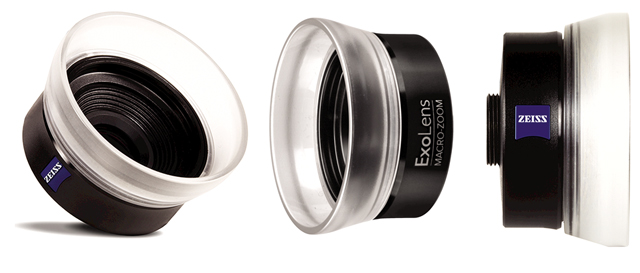
The Zeiss Macro lens is beautifully engineered in all metal construction with a unique translucent hood that helps to diffuse the light.
First impressions when unboxing were excellent as the lens is contained in a sturdy and attractive box – aesthetically similar to iPhone packaging. Inside is the beautifully crafted Macro lens with translucent lens hood along with a selection of brackets for iPhone6 and 7 bodies. There is also a front lens cap along with a tiny rear lens rubber cap (so small that it will almost certainly get lost). Finally, a black velvet bag in which to keep your lens clean completes the goodies.
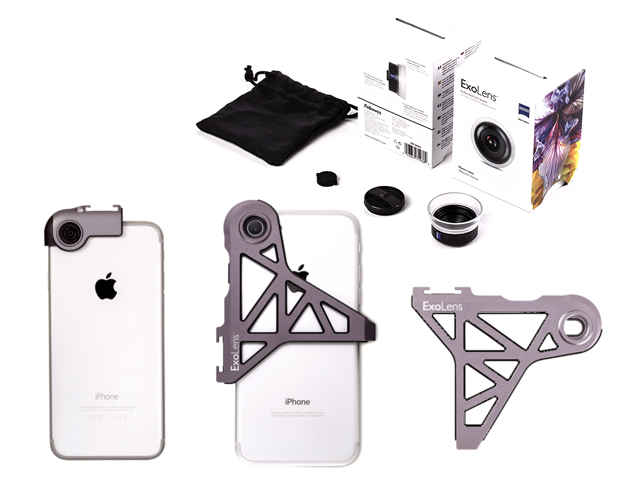
The Zeiss Macro lens comes with a selection of edge brackets for iPhone 6 and 7.
I prefer to use the more substantial bracket that came with the Zeiss Wide Angle lens because it has a screw on thread for tripod (essential for serious macro use).
A big challenge any external lens for a mobile phone faces is how to mount it on the device. While the macro lens came with a small side edge bracket I prefer using the larger Edge bracket that came with the Zeiss wide-angle lens. This bracket is much more suitable for macro as it has an indispensable thread that can be attached to a tripod while also having a hot shoe mount. The bracket is a tight fit and needs a firm push in order to slide onto the -iPhone. I prefer this to a loose fit because there’s little chance of the phone working itself loose.
I tested the Zeiss macro lens on a dragonfly exuvia in Kenfig Nature Reserve, near Bridgend, South Wales. I mounted the bracket on a tripod and used the apple earphones as a camera release (shots were taken by pressing the + volume control). This prevents the inevitable movement that one encounters when pressing the shutter button on the iPhone. I used an app called Manual that has manual focusing capabilities as well as being able to change the ISO.
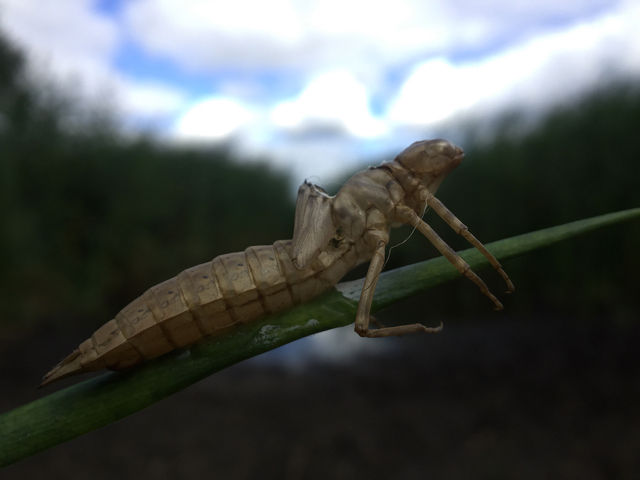
Pic 1: Zeiss Macro Lens – AV2.2 / TV 898 / ISO 32
Pic 1: The background is rather dark and under-exposed. However, the exuvia is well exposed and quite sharp appearing to pop out of the dark background.

Pic 2: Zeiss Macro Lens – AV2.2 / TV 964 / ISO 100
Pic 2: The background is a little over exposed resulting in some chromatic aberration (blue fringing) along the edges of where the background rushes meet the sky. The iPhone uses a set aperture of f2.2, which on a DSLR would give a buttery smooth background. The sensor on the iPhone is tiny by comparison resulting in more depth of field than equivalent with a DSLR. While not super smooth the background has just enough focus to be able to distinguish it as a lakeside. Most importantly, at ISO 100 the exuvia appears well exposed, and clearly defined.
The biggest limitation I found was not in the actual performance of the Zeiss lens but in the limitation of the iPhone 6 in not being able to shoot RAW. Post-production control is limited to JPEG which I find limiting when trying to control highlights and shadow detail. Nevertheless, I’m pretty pleased with the results of these two trial shots as they show some of the promising potential of the Zeiss lens.
Lets now compare these shots with another two taken using one of my sharpest macro lenses – the Iaowa 15mm macro on a Canon 7D.
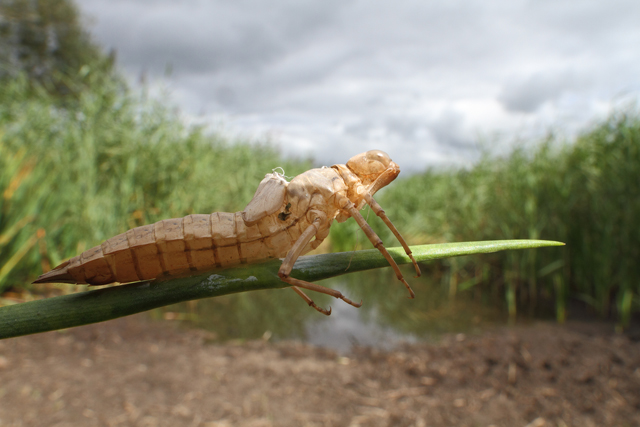
Pic 3: Iaowa 15mm Macro Lens – AV22/ TV 125 / ISO 400
Pic 3: The background is well exposed with no blown highlights. The grey of the clouds can clearly be seen (these were blown out in the iPhone shots). The ability to change aperture (not possible with the iPhone) meant that I could choose an aperture of f22 in order to increase depth-of-field and reveal some of the background detail i.e. the rushes are clearly more visible but not so much that they take your attention away from the foreground subject. The exuvia is very sharp with accurate rendition of both colour and tone.
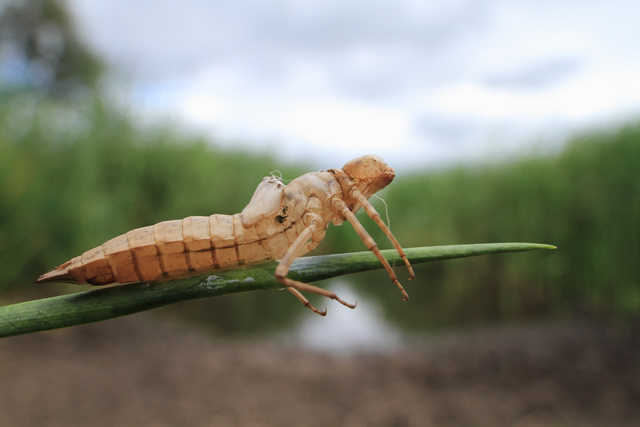
Pic 4: Iaowa 15mm Macro Lens – AV5.6/ TV 125 / ISO 400
Pic 4: The Iaowa 15mm lens gives me total control of aperture so that if I prefer I can blur the background by selecting a wide aperture of f5/6. Compare this to the f22 of Pic 1.
While the Zeiss lens makes macro photography a realistic proposition for mobile phone users, it nevertheless has some significant limitations. These limitations are made more apparent when one compares it to a dedicated DSLR macro lens. The biggest limitation is not the Zeiss lens itself but the actual iPhone lens and sensor. One has to remember that the Zeiss is a supplementary lens that attaches to the end of the iPhone lens. So no matter how good the Zeiss lens is, its ability to produce excellent images is always going to be restricted by the iPhone lens. This is a shame and the only way to reveal just how good this lens can be is to do away with the iPhone lens and attach the Zeiss lens directly in front of the camera sensor.
Conclusion
I would sum up that all the problems I encountered were not due to the Zeiss lens but to the restrictions of iPhone 6-camera technology.
Here are some of the frustrations I encountered:
- The inability to shoot RAW using iPhone 6 (this is now possible if using the latest iPhones)
- Having to rely on the iPhone screen as a viewfinder. I realize that many photographers may consider this an advantage and call me old fashioned but I prefer looking through a camera viewfinder any day! I find the glare and reflections on any screen annoying, making focusing a tedious process. Besides the camera viewfinder helps to cut out all peripheral distractions.
- The lack of tactile feedback. The feel of a camera, its controls and dials and the precise turning of the lens focus ring – all these things help to make photography more physical and enjoyable.
- Restricted to a fixed aperture with little control of depth of field.
- Touch screen focusing – not as precise as the fine adjustments of a focusing ring.
- Shutter – again rather remote and lacking the satisfying feel of a DSLR camera shutter release.
What about the good points?
- Impressive build quality of Zeiss lens – all metal construction worthy of the Pro attribution.
- Brings out the best of the iPhone lens – ads macro functionality without compromising quality.
- Ingenious, translucent lens hood that helps to diffuse light.
- Excellent value for money, now that price has dropped from the initial £200 to £39!
- Claimed 40 to 80mm zoom function when rotating the lens. Misleading, as there appears to be no discernable change in field of view when you turn the lens. It’s really a focus limiter dial that enables you to focus more closely as you turn the lens. Personally, I found this more annoying than useful as it was easy to forget to turn it when moving the lens to within a nats tail of the subject, resulting in out of focus shots. Providing one remembers to turn at the different focusing ranges then it’s a good function to have.
Would I use the Zeiss macro lens again? Most certainly YES! The best camera is the one that you have on you and having the iPhone and Zeiss lens makes this a much more realistic proposition than lugging my semi-pro macro gear with me wherever I go. Besides, I have many more tests to conduct and it will be interesting to see how the lens performs on live subjects and without a tripod. So on the whole, I’m very pleased with the Zeiss lens although I doubt whether I would have brought it at its original price of £200. At this price range one can buy a second hand DSLR Macro lens. For example, I brought my Tokina 35mm macro in mint condition for £160 and that has proved to be one of my favourite lenses, particularly for wide-angle macro. However, at £39 the Zeiss is a bargain!
Ultimately the quality of the images is the most important factor for any discerning photographer and as the test shots show, the Zeiss Exolens is no replacement for a dedicated DSLR macro lens. For the very best quality and engaging experience I’ll carry on lugging my heavy rucksack and using my much loved and trusted DSLR and macro lenses.

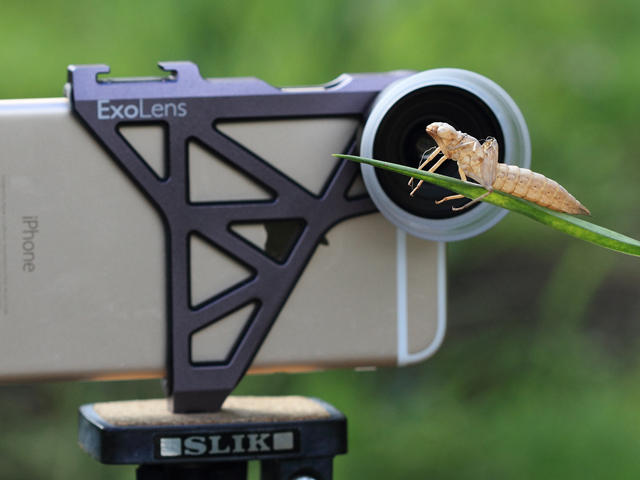
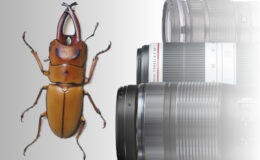
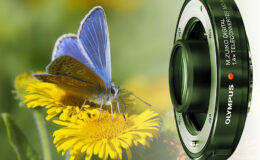

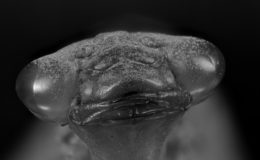

Leave a Comment